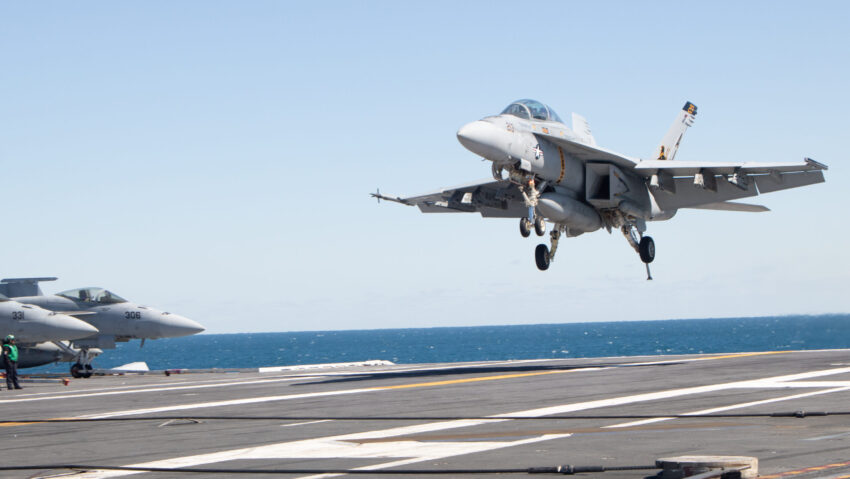An F/A-18 Super Hornet from Strike Fighter Squadron 213 lands aboard the USS Gerald R. Ford (CVN-78) (Photo by Justin Katz/Breaking Defense.)
WASHINGTON — The US Navy’s annual Unfunded Priorities List for fiscal 2026 includes $1.4 billion for a sixth-generation fighter aircraft as well as $2.2 billion to bolster the munitions industrial base and resupply key stockpiles, according to documents obtained by Breaking Defense.
“This additional funding will enable Navy to award the 6th Generation Strike Fighter contract to industry,” the Navy wrote in its letter to lawmakers. “Navy’s 6th Generation Strike Fighter aircraft is a critical component of both the future Carrier Strike Group (CSG)” and the “air wing of the future.”
The military services and combatant commanders each year send Congress their “unfunded priority lists,” which outline specific funding requests the services were not able to include in the president’s formal budget request.
The next-generation strike fighter, also dubbed F/A-XX, has been a contentious subject this year as lines have been ostensibly drawn between various factions in the Pentagon, White House and Congress on whether to proceed with the program in parallel to the Air Force’s own Next Generation Air Dominance fighter project.
Uniformed Navy brass and hawkish lawmakers have urged the administration to advance the new aircraft with a contract award to industry — Boeing or Northrop Grumman — while the White House, and at times even Navy Secretary John Phelan, have expressed reservations about F/A-XX’s future.
The Navy’s UPL also includes two requests focused on munitions programs: $1.4 billion to bolster the industrial base and $841 million targeting specific weapons programs that have been key to the service’s operations in the Red Sea.
The service writes that its industrial base is “unable to keep pace with the growing demand for increased production, requiring significant investment to build infrastructure and maintain requirement inventories.” The $1.4 billion request would address “bottlenecks in lower-tier munitions components … by establishing and qualifying second source vendors and expanding existing suppliers.”
The $841 million in targeted funding would replenish inventories for Standard Missile-6, Tomahawk Land Attack Missiles, Maritime Strike Tomahawk, Advanced Medium Range Air-to-Air Missile and Long-Range Anti-Ship Missiles.
“This funding increases procurement of SM-6 munitions from 139 to 150, maximizing the production line capacity. SM-6s are heavily relied upon for integrated air and missile defense and have been expended in the recent Red Sea conflict,” the letter to lawmakers says.
The Navy’s UPL also contains a number of smaller asks for a variety of other programs, totaling $7.4 billion, but notably does not include any additional requests for major surface combatants or submarine programs for the shipbuilding budget, which had become a staple of the document in previous years.
Meanwhile, the Marine Corps’ unfunded priorities list features roughly three dozen relatively small requests for various efforts associated with its ongoing Force Design, including funding for unmanned systems, munitions programs and aircraft spares, among other things, totaling $2.8 billion.
Click this link for the original source of this article.
Author: Justin Katz and Valerie Insinna
This content is courtesy of, and owned and copyrighted by, https://breakingdefense.com and its author. This content is made available by use of the public RSS feed offered by the host site and is used for educational purposes only. If you are the author or represent the host site and would like this content removed now and in the future, please contact USSANews.com using the email address in the Contact page found in the website menu.








